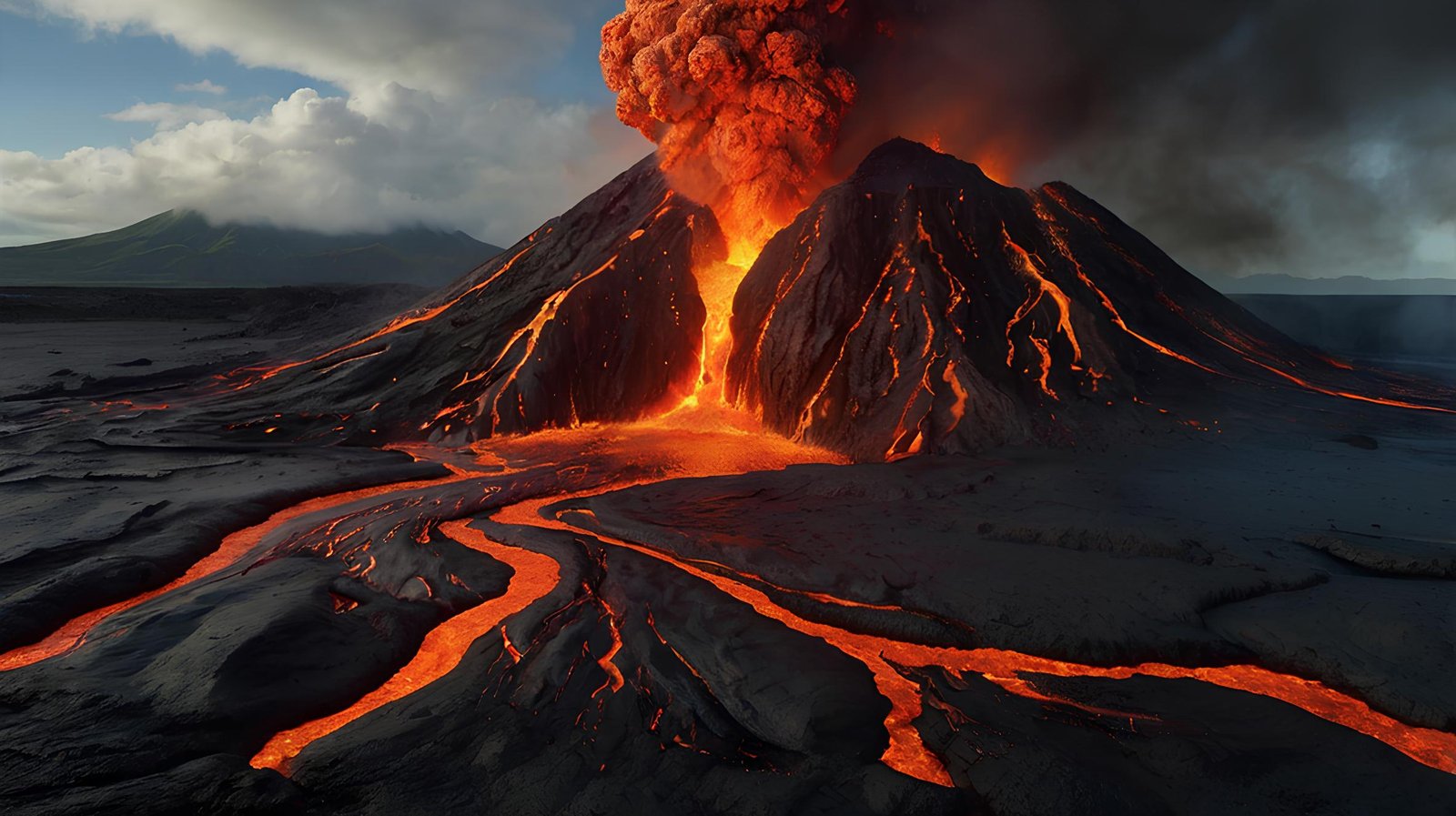Introduction
How volcanic eruptions shape the Earth is a subject of great geological significance. Volcanic eruptions are among the most powerful natural forces that continuously reshape the Earth’s surface. These eruptions not only destroy but also create, forming new landscapes over time.
From islands rising in the ocean to fertile soils that support agriculture, volcanoes have a lasting impact on landforms. The impact of volcanic eruptions on landforms depends on several factors, including eruption intensity and magma type. Understanding the long-term effects of volcanoes provides insight into the continuous evolution of the planet’s surface. What landforms are created by volcanoes is determined by various geological processes, ranging from explosive eruptions to slow lava flows. In this article, we will explore volcanic eruptions’ effects on landforms, their short-term and long-term consequences, and the various landscapes they shape. For more historical insights, check out this article on the Partition of India
How Volcanic Eruptions Shape the Earth
Volcanoes are geological wonders that continuously modify the Earth’s crust. The molten rock, ash, and gases released during an eruption contribute to the dynamic evolution of our planet’s landforms.
The Impact of Volcanic Eruptions on Landforms
Volcanic eruptions significantly alter landscapes in multiple ways, including destruction and creation of new features. Below are the major ways volcanic eruptions shape landforms:
1. Formation of Volcanic Mountains
- Volcanoes themselves are landforms that rise due to repeated eruptions.
- Examples include Mount Fuji (Japan), Mount St. Helens (USA), and Mount Etna (Italy).
- Shield volcanoes, composite volcanoes, and cinder cones are different types of volcanic mountains.
2. Creation of Lava Plateaus
- When lava spreads over large areas and cools, it forms flat, elevated plateaus.
- The Deccan Traps in India are an example of massive basaltic lava flows forming a plateau over millions of years.
3. Formation of Calderas
- Calderas form when a volcano collapses into itself after a massive eruption.
- Crater Lake in Oregon, USA, is a famous caldera formed from the collapse of Mount Mazama.
4. Development of Volcanic Islands
- Underwater eruptions can create entirely new islands.
- Hawaii and Iceland were both formed by volcanic activity.
5. Fertile Volcanic Soil for Agriculture
- Volcanic ash is rich in minerals, which enhances soil fertility.
- Regions near Mount Vesuvius in Italy and the Andean volcanic belt in South America benefit from highly productive farmlands.
6. Formation of Volcanic Lakes
- Some volcanic eruptions create depressions that later fill with water, forming lakes.
- Examples include Lake Toba (Indonesia) and Lake Taupo (New Zealand).
7. Long-Term Effects of Volcanoes on Landscapes
Volcanic activity has both immediate and lasting consequences on landforms.
Short-Term Effects:
- Rapid destruction of landscapes through lava flows and ash deposits.
- Formation of new rock layers.
- Temporary climate cooling due to volcanic ash blocking sunlight.
Long-Term Effects:
- Erosion of volcanic deposits forms new geological features over centuries.
- Increased biodiversity due to the creation of new habitats.
- Long-term soil enrichment that supports forests and agriculture.
What Landforms Are Created by Volcanoes?

Volcanic eruptions lead to the formation of various landforms, including:
- Stratovolcanoes – Tall, steep-sided volcanoes like Mount Rainier.
- Shield Volcanoes – Broad, gently sloping formations like Mauna Loa in Hawaii.
- Lava Domes – Small, rounded hills formed by slow lava extrusion.
- Cinder Cones – Short, steep volcanoes made of volcanic ash.
FAQs About Volcanic Eruptions and Landforms
1. How do volcanic eruptions affect climate?
Volcanic eruptions’ effects on climate can be significant. Large eruptions release sulfur dioxide, which creates reflective particles in the atmosphere, causing temporary cooling. The long-term effects of volcanoes may include increased greenhouse gas emissions. What landforms are created by volcanoes, such as calderas and lava plateaus, can also influence local weather patterns.
2. Can volcanoes create permanent landforms?
Yes, volcanic eruptions shape the Earth by forming islands, mountains, and plateaus. The impact of volcanic eruptions on landforms is evident in places like Iceland and Hawaii, where new landmasses emerge. These landforms undergo slow erosion, but many remain for thousands of years, contributing to Earth’s evolving geography.
3. Are there any benefits to volcanic eruptions?
Volcanic eruptions provide fertile soil, geothermal energy, and mineral-rich deposits. The long-term effects of volcanoes include the enrichment of landscapes, supporting agriculture. How volcanic eruptions shape the Earth positively can be seen in regions where farming thrives due to mineral-rich volcanic ash.
4. How does volcanic ash impact the environment?
Volcanic eruptions’ effects on ecosystems vary. While ash can damage crops and affect air quality, it eventually enriches soil fertility. The impact of volcanic eruptions on landforms includes ash deposits that form new terrain. Many volcanic regions later become highly productive agricultural zones due to this natural enrichment.
5. Which is the largest volcanic eruption recorded in history?
The eruption of Mount Tambora in 1815 was among the most powerful. It led to the “Year Without a Summer,” affecting global climate patterns. Understanding the long-term effects of volcanoes like Tambora helps scientists analyze how volcanic eruptions shape the Earth and influence future geological changes.
Conclusion
How volcanic eruptions shape the Earth is evident in the creation of mountains, islands, and fertile lands. These eruptions play a crucial role in landform evolution, altering the landscape through lava flows, ash deposits, and explosive activity. The impact of volcanic eruptions on landforms is long-lasting, as new geological formations emerge while others erode over time. What landforms are created by volcanoes depends on various factors, including eruption intensity and magma composition. From the towering stratovolcanoes of the Pacific Ring of Fire to the vast lava plateaus of India’s Deccan Traps, volcanoes are key architects of the Earth’s surface.
The long-term effects of volcanoes extend beyond physical changes, influencing climate, ecosystems, and human settlements. Volcanic eruptions’ effects range from immediate destruction to the gradual development of mineral-rich soils that support agriculture. Many civilizations have thrived on volcanic lands due to their fertility, while others have faced devastation from eruptions. Understanding these processes helps scientists and communities better prepare for future eruptions and harness the benefits of volcanic landscapes. By studying these phenomena, we gain deeper insights into Earth’s dynamic nature and the forces that continue to reshape it..
Sources & References:
Comment your thought below
If you found this article informative, share it with others interested in Earth’s geological processes! Have questions? Drop a comment below, and let’s discuss how volcanoes shape our world!
📢📢Unlock Your Online Potential with Hostinger!
Struggling with Social Media addiction? To know about The Dark Side of Social Media Click Here
Turn your screen time into income by creating a money-making website! With Hostinger’s affordable hosting, you can:
✅ Build a blog, e-commerce store, or portfolio in minutes
✅ Monetize through ads, affiliate marketing, or digital products
✅ Enjoy lightning-fast speed & 99.9% uptime
Exclusive 20% OFF for our readers:
👉 Hostinger Affiliate Link
Why Hostinger ?
✔ 1-click WordPress install (perfect for beginners!)
✔ 24/7 live chat support
✔ Free SSL certificate (secure your site)
Example Success:
Riya, a former Social Media addict, now earns ₹50,000/month from her self-care blog—built on Hostinger in just 2 days!
Your Turn:
1️⃣ Sign up with our link
2️⃣ Launch your site (use detox tips as content!)
3️⃣ Start earning while helping others break free!
💡 “Your phone is a goldmine—stop scrolling, start selling!”
**Affiliate Disclosure – “This page contains affiliate links. We may earn a commission at no extra cost to you.
